Physical Address
304 North Cardinal St.
Dorchester Center, MA 02124
Inflammatory disorders of the skin have typically been classified by etiology (suspected or confirmed), clinical features, histologic features (e.g., reaction patterns), location in the skin, or all of the above, as remains the tradition in Foundations in Diagnostic Pathology . As our collective understanding of inflammatory skin disorders continues to evolve, no single uniform classification of disease has been or is likely to be perfect for all uses in the foreseeable future. Instead, as many disorders as possible are classified by etiology, and the remainder are based on distinctive features. Complicating matters, some specific diseases may cause more than one clinical or histopathologic appearance (and multiple names), and some groups of unrelated diseases may have identical clinical or histopathologic manifestations. The subject headings in this chapter represent clinically relevant topics that are biopsied with reasonable frequency and embody a traditional and fairly comprehensive presentation of the material in this field in a way that is designed to be useful as a reference as well as from the standpoint of evaluating new cases.
The practicing dermatopathologist is challenged by the fact that one's interpretations are directly based only on microscopic features of the case in question, sometimes with only minimal additional clinical information of variable quality. Moreover, with the exception of infectious diseases, the instant pattern recognition that is often accomplished when evaluating neoplastic disorders is less frequently the case when examining a biopsy of a rash. An overall assessment of the patient based on both clinical (i.e., gross pathology) and histologic (i.e., microscopic pathology), including a case-by-case judgment of the relative importance of these two components, generally yields the most precise diagnosis or differential diagnosis. The final responsibility for this judgment necessarily falls on the submitting physician. The aim of the dermatopathologist should be to provide the submitting physician with a clinically relevant differential diagnosis (in the standard language of clinical dermatology) based primarily on the microscopic features, and, when possible, a specific diagnosis. Caveat: Specific diagnoses issued by pathologists whose diagnoses have been clinically disproved (read: wrong per the submitting dermatologist) carry little weight. Keeping an open mind and maintaining communication with submitting physicians are essential to refining one's diagnostic skills (and reputation) in the area of inflammatory skin disease.
It is essential to recognize that although spongiotic dermatitis is perhaps the most frequently biopsied inflammatory skin disease, it is not a single clinical disorder ( Table 1-1 ). Rather, spongiotic dermatitis is a descriptive diagnosis that corresponds to a variety of clinical disorders, some of which are completely unrelated. The fact that the most common group of disorders manifesting as spongiotic dermatitis are designated variably and imprecisely by submitting physicians, including dermatologists, is a source of confusion to students and practitioners of medicine. These designations include eczema, dermatitis, and eczematous dermatitis. Unless further specified, these terms are considered synonymous and are referred to herein as eczematous dermatitis. The term eczematous dermatitis still does not correspond to a single clinical disorder, but it does correspond to a more limited number of specific, common clinical disorders, including atopic dermatitis (designated by some as atopic eczema, or simply eczema), allergic contact dermatitis, photoallergic contact dermatitis, nummular dermatitis (or nummular eczema), dyshidrotic dermatitis (or dyshidrotic eczema), and the Id reaction. Stasis dermatitis, xerotic dermatitis ( Fig. 1-1 ), and pityriasis alba may also be added to this list. A subgroup of these disorders clinically exhibits superimposed urticarial features, designated urticarial dermatitis. To confuse matters further, submitting physicians sometimes refer to any one of these specific disorders simply as eczema or dermatitis. The most common example is eczema as a synonym for atopic dermatitis or atopic eczema.
Eczema does not represent one disease entity but rather a spectrum of diseases that share the histologic feature of spongiotic dermatitis.
Children and adults
May be associated with personal or family history of asthma (atopic dermatitis)
Atopic dermatitis:
Children in acute phase: extensor surfaces and face
Chronic form: flexural sites
Seborrheic dermatitis: scalp, ear, face, and central chest
Allergic or contact dermatitis: site of exposure
Acute phase
Erythematous or edematous papules and plaques
Vesicles may develop with oozing, serous crusts
Subacute phase
Erythematous papules and plaques
Scales and excoriations common
Chronic phase
Thickened hyperkeratotic plaques
Lichenification (lichen simplex chronicus)
Nodule formation (prurigo nodularis)
Postinflammatory pigment changes
Pruritus
Xerosis (dry skin)
Except for contact dermatitis, usually chronic disease
Topical steroids for atopic dermatitis
Topical azoles and zinc pyrithione shampoos for seborrheic dermatitis
Moisturizers
Avoidance of exposure to triggers or stimulants
| Atopic Dermatitis | Nummular Dermatitis | Dyshidrosis | Seborrheic Dermatitis | Allergic Contact Dermatitis | Irritant Contact Dermatitis | Papular Dermatitis | Urticarial Dermatitis | Pityriasis Rosacea | |
|---|---|---|---|---|---|---|---|---|---|
| Superficial perivascular lymphocytes | ++ | ++ | ++ | ++ | ++ | ++ | ++ | ++ | ++ |
| Deep perivascular lymphocytes | 0 | 0 | 0 | 0 | 0 | 0 | 0 | ± | 0 |
| Epidermal necrosis | 0 | 0 | 0 | 0 | 0 | ++ | ± | 0 | 0 |
| Follicular spongiosis | ± | 0 | 0 | ++ | 0 | 0 | ± | 0 | 0 |
| Dermal eosinophils | ± | ± | ± | ± | ++ | ± | ++ | ++ | ± |
| Lymphocyte exocytosis | ± | ± | ± | ± | ± | ± | 0 | 0 | ++ |
| Erythrocyte extravasation | 0 | 0 | 0 | 0 | 0 | 0 | 0 | 0 | ++ |
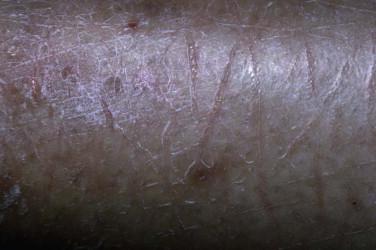
The clinical common denominators of eczematous dermatitis are acutely pruritic, erythematous, and variably edematous papules and papulovesicles that quickly rupture, leaving discrete or coalescent foci of crusts and scale. Often the vesicles are fragile and pruritic enough that intact vesicles are not observed because they are promptly excoriated. As the condition persists, the papules and vesicles may coalesce into relatively poorly demarcated (e.g., compared with psoriasis) erythematous plaques containing crust and scale. As the condition persists further, longstanding lesions become lichenified and may evolve into lichen simplex chronicus (LSC), becoming less erythematous but more thickened, hyperpigmented or hypopigmented, and lichenified, with more prominent skin lines.
The primary feature of spongiotic dermatitis is the presence of epidermal spongiosis. Spongiosis is defined as intercellular edema between epithelial cells, appearing on light microscopy as widened intercellular spaces that allow the intercellular bridges between epithelial cells to be observed more easily. Pronounced spongiosis results in the formation of intraepithelial spongiotic vesicles that correspond to clinically observed papulovesicles when large enough to be appreciated grossly. Spongiotic vesicles exhibit a round or inverted flask shape, usually contain lymphocytes or Langerhans cells, and exhibit spongiosis at their periphery. The underlying dermis usually exhibits a superficial perivascular and variably interstitial predominantly lymphocytic infiltrate. Histiocytes, eosinophils, or neutrophils are variably present. Spongiotic vesicles need to be distinguished from Pautrier microabscesses of mycosis fungoides (MF), which are intraepidermal collections of atypical lymphocytes without significant associated spongiosis or Langerhans cells.
In acute spongiotic dermatitis, the stratum corneum exhibits undisturbed basket-weave orthokeratosis ( Fig. 1-2, A ). The presence of parakeratosis signifies subacute spongiotic dermatitis. In chronic spongiotic dermatitis, there is epidermal hyperplasia characterized by a thickened (acanthotic) epidermis with elongated rete ridges and hypergranulosis, although hypogranulosis may be present in areas exhibiting spongiosis. In chronic spongiotic dermatitis, spongiosis is often minimal (e.g., often lacking spongiotic microvesiculation). With sufficient chronicity, the histopathologic picture evolves to LSC, with compact orthokeratosis and papillary dermal fibrosis ( Fig. 1-2, B ). Superimposed excoriation is frequent, with variable erosion or ulceration, junctional fibrin, extravasated erythrocytes, and superficial fibrovascular granulation tissue.
Spongiotic dermatitis
Acute: spongiosis with or without intraepidermal vesicle
Subacute: spongiosis and parakeratosis
Chronic: psoriasiform epidermal hyperplasia
Superficial dermal lymphocytic infiltrate with or without eosinophils
PAS, PAS-D, or GMS stain to exclude fungal infection
Spongiotic drug reaction
Mycosis fungoides
Tinea
GMS, Gomori methenamine; PAS, periodic acid-Schiff; PAS-D, periodic acid-Schiff with diastase digestion.
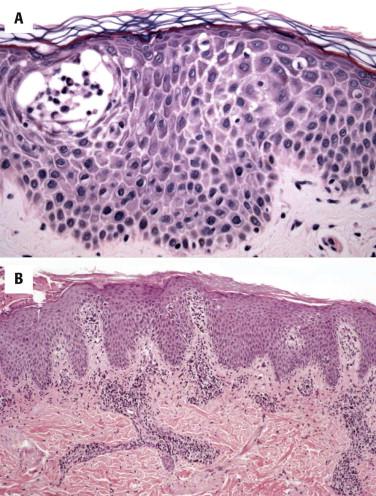
Histochemical stains (periodic acid-Schiff [PAS], PAS with diastase digestion [PAS-D], or Gomori methenamine silver [GMS]) are routinely used in spongiotic dermatitis to exclude dermatophytosis. Direct immunofluorescence (DIF) may be required if immunobullous disorders such as pemphigoid or pemphigus are clinical concerns.
The pathologist may narrow the differential diagnosis based on the biopsy site and submitted clinical information but should not attempt to unequivocally distinguish different forms of spongiotic dermatitis based on histopathologic features alone. The clinician determines the final clinical-pathologic diagnosis based on clinical pathologic correlation. Histopathologic features that may suggest a specific disorder are discussed in the sections below.
Failure to identify dermatophytosis is a common diagnostic pitfall. These should be most strongly considered for cases with a clinical suspicion for tinea or in which central clearing or annular lesions or disorders (e.g., granuloma annulare [GA]) are described. Histologically, a parakeratotic neutrophilic crust or prominent dermal eosinophils are typical of dermatophytosis.
Drug reactions may be suspected when eosinophils are prominent or when a mixed pattern is present (e.g., combined spongiotic and interface). Ultimately, drug reactions require clinical correlation and may not be excluded based on histology alone.
The early, prebullous phase of immunobullous disorders such as pemphigus and pemphigoid typically require DIF testing. Early pemphigus and pemphigoid usually exhibit eosinophilic spongiosis or neutrophilic spongiosis and may exhibit subtle acantholysis (pemphigus) or focal subepidermal clefting (pemphigoid).
Distinction among spongiotic dermatitis, parapsoriasis, and patch or plaque (stages Ia–Ib) mycosis fungoid can be difficult because of overlapping clinical, histologic, and immunophenotypic features. This differential diagnosis is discussed in detail in Chapter 14 (Hematopoietic Neoplasms). Briefly, classic lesions of MF are characterized by increased numbers of atypical lymphocytes in the basilar epidermis and minimal or absent spongiosis compared with conventional spongiotic dermatitis.
Spongiosis (usually mild) may also occur as a nonspecific, secondary feature in other inflammatory processes, including interface dermatitis, vasculitis, diffuse dermal infiltrates (e.g., Sweet's syndrome), or cases with marked papillary dermal edema.
In chronic spongiotic dermatitis exhibiting psoriasiform hyperplasia but only minimal spongiosis, it is sometimes impossible to exclude psoriasis. Moreover, contact dermatitis may be superimposed upon psoriasis. Typically, psoriasis exhibits more prominent or consistent loss or diminution of the granular layer (hypogranulosis), chronic spongiotic dermatitis exhibits hypergranulosis except in areas of active spongiosis, where hypogranulosis may be present. The presence of non-neutrophilic spongiotic microvesiculation is not typical of psoriasis. Other typical features of psoriasis are described in the following section.
Because spongiotic dermatitis is not a disease sui generis, the prognosis, natural history, and management of spongiotic dermatitis depend on the specific clinical-pathologic diagnosis, the major forms of which are discussed in the sections that immediately follow. Nevertheless, most cases of spongiotic dermatitis respond to topical corticosteroids. Mid- to super-high (class 1) potency may be required on the hands and feet. Occlusion of topical steroids, intralesional injection of corticosteroid, and short courses of systemic corticosteroids (intramuscular or oral) may be helpful in refractory areas. Nonsteroidal topical agents include tacrolimus ointment and pimecrolimus cream. Oral antihistamines help to suppress pruritus, and their sedative effects are sometimes beneficial. Phototherapy may be helpful in severe or refractory cases.
Acute allergic contact dermatitis frequently manifests as papules, vesicles, or plaques in linear array at the sites where the offending agent (commonly poison ivy and poison oak) brushed the skin ( Fig. 1-3, A ). In these cases, the diagnosis is usually obvious, and patients are rarely biopsied. Subacute or chronic allergic contact dermatitis may be clinically indistinguishable from atopic, nummular, or dyshidrotic dermatitis or LSC. In some cases, the diagnosis may be established based on the suggestive shape or distribution of lesions, the clinical history, or patch testing. Common allergen sources include plants, metals ( Fig. 1-3, B ), and skin care products (fragrances, antibiotics, preservatives). Allergic contact dermatitis on the face or groin may present as diffuse edema resembling cellulitis.
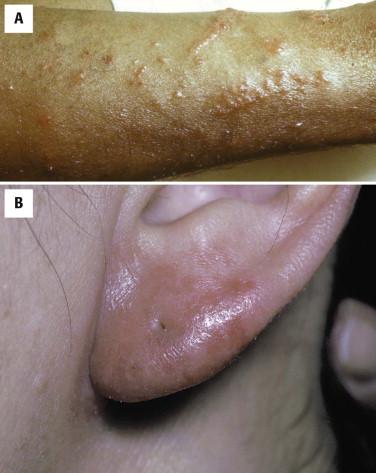
For general features, see Spongiotic Dermatitis. Allergic contact dermatitis cannot be reliably or consistently distinguished from other forms of eczematous dermatitis based on assessment of histopathologic features alone. The presence of eosinophils has traditionally been regarded as characteristic. Dermal eosinophils, eosinophilic spongiosis, and papillary dermal edema are often present, but their absence does not preclude the possibility of this diagnosis. Likewise, the presence of dermal neutrophils is variable and not required. Chronic photoallergic contact dermatitis may exhibit deep perivascular extension of the dermal infiltrates. Rare variants of allergic contact dermatitis include urticarial (e.g., latex), systemic, pustular (e.g., cement), purpuric (e.g., textile dyes), granulomatous (e.g., gold), lymphomatoid (e.g., nickel), and contact dermatitis with prominent postinflammatory hypopigmentation (leukodermic variant).
If the culprit is not revealed by a detailed exposure history, diagnostic patch testing may reveal the etiology. However, not all patch test results are clinically relevant, and interpretation of test results may be confounded by false-negative or false-positive (irritant) reactions.
Photocontact dermatitis, particularly chronic cases, may exhibit deep perivascular extension of the dermal inflammatory cells (see Spongiotic Dermatitis ).
Allergic contact dermatitis subsides if the allergen is withdrawn. The challenges in most cases are the identification and effective removal of the allergen from the patient's environment (see Spongiotic Dermatitis ).
Irritant contact dermatitis is often clinically obvious, suggested by the pattern of inflammation corresponding to the site of contact with the irritant. The severity of the reaction is proportional to the severity of the exposure or the nature of the irritant in dose-dependent fashion. In contrast to allergic contact dermatitis, prior sensitization is not required. Compared with allergic contact dermatitis, atopic dermatitis, nummular dermatitis, and dyshidrotic dermatitis, pruritus is less characteristic. Mild reactions resemble allergic contact dermatitis. Severe irritants (e.g., chemical burn) may cause large blisters (bullae), may cause erosion or ulceration, and may leave scars. Dermatitis associated with dry skin (xerotic dermatitis, asteatotic dermatitis, eczema craquelé) may be regarded as a variant of irritant dermatitis.
For general features, see Spongiotic Dermatitis. The histopathologic features of irritant contact dermatitis depend on the severity of the irritant and extent of exposure. Severe irritants cause confluent epidermal necrosis with “ghost” nuclei caused by a loss of nuclear basophilia, either within the superficial epidermis or full thickness. Mild irritants or lesser exposure may result in single necrotic keratinocytes within the suprabasal epidermis associated with spongiosis. Dermal eosinophils and neutrophils are variable.
Single necrotic keratinocytes are usually located above the basal layer in irritant dermatitis, but in interface dermatitis, they are found mostly along the dermal-epidermal junction. Single necrotic keratinocytes at the junction may also reflect wound healing from secondary excoriation by the patient (see Spongiotic Dermatitis ).
Removal of the offending agent is curative. Otherwise the condition persists depending on the frequency and severity of exposure (see Spongiotic Dermatitis ).
Round erythematous plaques that typically manifest in the shape and approximate size of coins characterize nummular dermatitis. There is a predilection for the extremities. Plaques may be crusted (wet) or dry and scaly. Outbreaks are often seasonal, associated with the onset of hot and humid, or more often, cold and dry winter weather. Emotional stress may also play a role in some cases.
For general features, see Spongiotic Dermatitis. Nummular dermatitis cannot be reliably or consistently distinguished from other forms of eczematous dermatitis based on the assessment of histopathologic features alone.
Nummular dermatitis is usually diagnosed based on clinical features alone, without biopsy. It is essential for the pathologist to exclude dermatophytosis.
Clinically, nummular dermatitis may resemble other forms of spongiotic dermatitis, as well as dermatophytosis, psoriasis, parapsoriasis, patches or plaques MF, as well as Bowen's disease or superficial basal cell carcinoma. If lesions are located on the legs, the differential diagnosis may include xerotic dermatitis and stasis dermatitis. Xerotic dermatitis is primarily a clinical diagnosis. Stasis dermatitis should exhibit concomitant changes of venous stasis, including clusters of small thick-walled vessels in the upper dermis or full thickness of the dermis, associated with extravasated erythrocytes and hemosiderin. If venous stasis change is minimal or inactive (e.g., vascular changes, but no hemorrhage), the possibility of nummular or other spongiotic dermatitis superimposed on a background of venous insufficiency cannot be excluded.
There is a chronic waxing and waning course (see Spongiotic Dermatitis ).
Atopic dermatitis (commonly designated eczema) is associated with a personal or family history of atopy, including asthma, allergic rhinitis, and allergic conjunctivitis. Atopic dermatitis is most common in infancy and childhood. Atopic dermatitis is known as the “itch that scratches” because pruritus often appears before a significant visible skin lesion. The earliest lesions are believed to be papulovesicles, akin to those that may be observed in acute spongiotic dermatitis. However, in atopic dermatitis, intact vesicles are rarely observed because papulovesicles are promptly excoriated, resulting in crusted papules that coalesce into ill-defined plaques. Atopic dermatitis is most common in childhood, and plaques involve the antecubital and popliteal fossae. Chronically manipulated lesions become scaly, lichenified, and dyspigmented ( Fig. 1-4, A ). Secondary impetiginization with Staphylococcus aureus or secondary herpes simplex virus (HSV) infection (eczema herpeticum) may occur. Papular or follicular atopic dermatitis is most common in dark-complected children ( Fig. 1-4, B ).
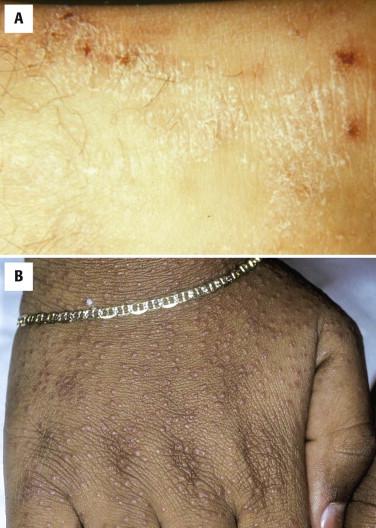
For general features, see Spongiotic Dermatitis. Atopic dermatitis cannot be reliably or consistently distinguished from other forms of eczematous dermatitis based on the assessment of histopathologic features alone, but biopsy is rarely required for diagnosis. Biopsies of atopic dermatitis are usually taken from subacute or chronic lesions, so parakeratosis, epidermal hyperplasia with hypergranulosis, and superimposed LSC (see section following) are typical, and spongiosis itself is often mild. Papular or follicular atopic dermatitis is characterized by spongiosis involving the infundibula of hair follicles. Lesions of atopic dermatitis are particularly susceptible to secondary bacterial impetiginization by S. aureus or HSV superinfection. Impetiginized lesions are characterized by clusters of gram-positive cocci within the crust areas of the stratum corneum. HSV infections are characterized by intraepidermal vesiculation with ballooning and multinucleation of keratinocytes and a steel gray appearance of infected keratinocytes nuclei with peripheral margination of nuclear chromatin.
The diagnosis of atopy is determined by the patient's personal and family history and clinical findings. Atopic dermatitis is invariably pruritic and characteristically involves the antecubital and popliteal fossae. Atopic dermatitis may exhibit prominent lichenification and postinflammatory hyperpigmentation or hypopigmentation. Most cases do not require biopsy for diagnosis.
However, atypical cases may be biopsied to evaluate for MF, psoriasis, pityriasis rubra pilaris (PRP), or other disorders. Follicular atopic dermatitis is clinically and histologically indistinguishable from a rare disorder, recurrent and disseminate infundibulofolliculitis, which has been reported in individuals without history of atopy. Miliaria rubra and Fox-Fordyce disease (apocrine miliaria) are clinically distinctive disorders characterized by spongiosis of acrosyringium and apocrine duct, respectively. However, depending on the plane of section, it may be difficult to determine whether focal spongiosis is associated with follicular, eccrine ductal, or apocrine ductal epithelium. Pityriasis alba is characterized by hypopigmented patches with fine pityriasiform scale, most commonly on the face of dark-complected children, on whom it is generally not biopsied. The process may be generalized and involve the trunk and extremities. It is widely believed to represent postinflammatory hypopigmentation secondary to atopic dermatitis.
See Spongiotic Dermatitis. Atopic dermatitis is common in infancy and childhood and typically resolves or diminishes in severity with advancing age. Atopic individuals are particularly susceptible to S. aureus superinfection, and a 2-week course of dicloxacillin or cephalexin will often improve refractory cases, especially if there is significant crusting of lesions. New-onset, unexplained, generalized eczema or atopic dermatitis in older adults without satisfactory explanation should evoke consideration of a drug reaction or, rarely, occult malignancy.
Dyshidrotic dermatitis (also designated pompholyx ) is characterized by small “tapioca pearl”–like vesicles bilaterally on the fingers or toes. There is a tendency to involve the lateral aspects of the digits ( Fig. 1-5 ). Vesicles may coalesce or extend onto the palms or soles but generally not beyond the wrist or ankle. In milder cases that do not exhibit visible vesicles, the more general term hand dermatitis is sometimes used. In severe acute cases, there may be extension to the distal extremities.
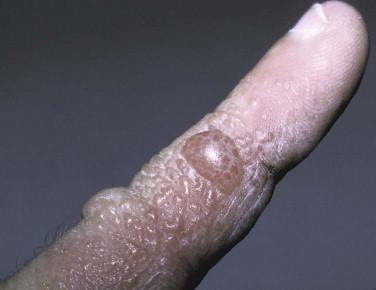
For general histologic features, see Spongiotic Dermatitis. Dyshidrotic dermatitis cannot be reliably or consistently distinguished from other forms of eczematous dermatitis based on assessment of histopathologic features alone. However, the diagnosis may only be considered when the hands or feet are involved, usually symmetrically.
Dyshidrotic dermatitis is usually diagnosed based on clinical features alone, without biopsy. The pathologist should exclude vesiculobullous lesions caused by dermatophytes, which may be clinically indistinguishable from dyshidrotic dermatitis. Dyshidrotic dermatitis may also be clinically indistinguishable from contact dermatitis limited to acral skin. Patients with tinea pedis may develop an Id reaction with dyshidrotic dermatitis on the hands and sometimes a generalized eczematous dermatitis. Id reactions may occur during initiation of systemic antifungal therapy for tinea pedis or onychomycosis.
See Spongiotic Dermatitis. Unless a cause can be identified and removed (see Id reaction), dyshidrotic dermatitis usually exhibits a chronic, waxing and waning course. Emotional stress has been implicated as a cause.
Seborrheic dermatitis is common in adulthood, exhibiting a soft, greasy scale and erythema, with a predilection for the scalp, eyebrows, nasolabial and retroauricular skin folds ( Fig. 1-6 ), and upper trunk. Inguinal skin folds are less commonly involved. Seborrheic dermatitis is also common in newborns.
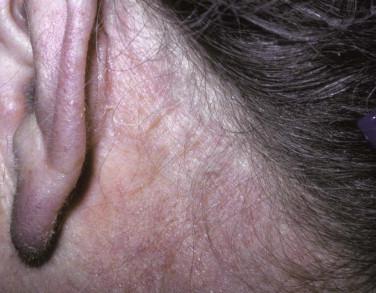
Seborrheic dermatitis cannot be reliably or consistently distinguished from other forms of eczematous dermatitis based on assessment of histopathologic features alone. However, classic examples of seborrheic dermatitis exhibit spongiosis localized to the ostia or upper infundibula of hair follicles. A neutrophilic crust is commonly present. Colonizing Pityrosporum ( Malassezia ) yeast spores may be present in the stratum corneum or superficial follicular orifice.
See Spongiotic Dermatitis. Seborrheic dermatitis is usually clinically sufficiently diagnostic. Occasionally, chronic seborrheic dermatitis is clinically or histologically indistinguishable from psoriasis.
See Spongiotic Dermatitis. Seborrheic dermatitis usually exhibits a chronic, waxing and waning course. In addition to topical corticosteroids, topical ketoconazole, medicated (e.g., coal tar, selenium sulfide, zinc sulfate) shampoos, and topical tacrolimus are also often helpful.
Papular dermatitis describes adults with refractory pruritic papules of unknown etiology with a predilection for the trunk, pelvis, and proximal extremities ( Fig. 1-7, A ). Papular dermatitis has been equated to what other observers have previously designated subacute prurigo and itchy red bump disease. Individuals with papular dermatitis may have some atopic features but not enough to warrant a diagnosis of atopic dermatitis. The incidence of papular dermatitis is unknown but is believed to be underrecognized, with cases likely being “lumped” into established diagnostic categories (e.g., atopic dermatitis, arthropod bite reactions).
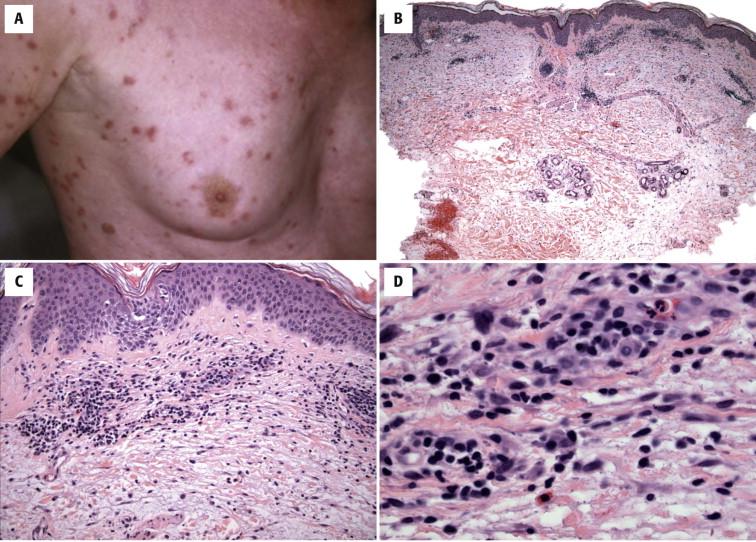
Papular dermatitis is characterized by minimal spongiosis and dermal perivascular lymphocytes with eosinophils ( Fig. 1-7, B–D ). These nonspecific changes have historically been classified under various headings, particularly dermal hypersensitivity reaction (DHR) pattern, by many pathologists and, subsequently, some clinicians. In contrast to urticaria, lesions may be excoriated. In subacute prurigo the spongiosis has been reported to be localized to follicular infundibula.
As with most forms of spongiotic dermatitis, the diagnosis of papular dermatitis is primarily based on clinical features. Cases entirely devoid of spongiosis exhibiting otherwise identical dermal changes may represent nondiagnostic samplings of papular dermatitis. Papular presentations of other forms of spongiotic dermatitis, most commonly follicular atopic dermatitis, cannot be reliably distinguished from papular dermatitis without clinical correlation. Likewise, the diagnosis of pruritic urticarial papules and plaques of pregnancy (PUPPP) requires clinical correlation. Arthropod bite reactions typically exhibit denser and deeper dermal perivascular involvement and more prominent eosinophils. Scabies typically exhibits very prominent eosinophils and crust. The urticarial stage of bullous pemphigoid can be confirmed by DIF analysis. Papular acrodermatitis (Gianotti-Crosti disease) exhibits variable histopathologic features that may include spongiotic or lichenoid features.
Papular dermatitis typically exhibits a chronic, waxing and waning course. Topical corticosteroids, oral antihistamines, and phototherapy may be beneficial. Systemic immunosuppressive therapy (mycophenolate mofetil) has been reported.
Urticarial dermatitis designates a subset of the DHR pattern. The term urticarial dermatitis includes many patients with DHR who present clinically with pruritic urticarial eczematous plaques rather than only papules. The incidence of urticarial dermatitis is unknown, but akin to papular dermatitis, may be underrecognized; case series from the United States and Australia have been reported to date.
Urticarial dermatitis is characterized by minimal spongiosis with normal stratum corneum (e.g., no parakeratosis) and upper dermal perivascular lymphocytes with eosinophils (i.e., identical to papular dermatitis) ( Fig. 1-7, B–D ).
As with most forms of spongiotic or eczematous dermatitis, the diagnosis of urticarial dermatitis is primarily based on clinical features and does not designate a specific disease entity. Most cases appear to be idiopathic, but some cases can be classified more specifically, including drug reactions, urticarial pemphigoid, atopic dermatitis, or contact dermatitis. In contrast to papular dermatitis, the differential diagnosis for urticarial dermatitis does not include arthropod bite reactions, but scabies, PUPPP, dermatitis herpetiformis, viral exanthems, and cutaneous T-cell lymphoma have rarely been documented.
Urticarial dermatitis may be managed with topical corticosteroids and oral antihistamines. Phototherapy and dapsone may be beneficial in selected cases.
Pityriasis rosea (PR) is a common, seasonal (spring, fall), self-limited eruption usually affecting children and young adults, manifesting as multiple round or oval erythematous papules, patches, or plaques with a collarette of pityriasiform (branlike) scale ( Fig. 1-8, A ) distributed in a “Christmas tree” pattern on the trunk (following relaxed skin tension lines on either side of the midline). The inguinal and axillary skin folds may be involved in inverse PR. A single lesion preceding by 1 to 2 weeks the onset of the generalized eruption is often identified (herald patch or mother patch) and is often larger than all subsequent lesions. Many individuals experience flulike symptoms before the onset of the herald patch or during the early stages of the eruption. PR is widely suspected of being virus induced, but no specific etiology has been consistently identified.
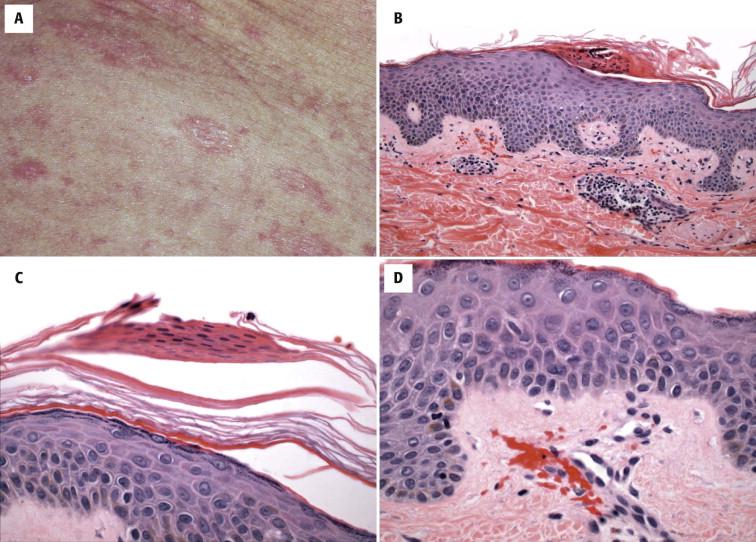
Pityriasis rosea cannot always be reliably or consistently distinguished from other forms of spongiotic dermatitis based on assessment of histopathologic features alone. Classic examples of PR exhibit periodic foci of spongiosis with overlying focal parakeratosis ( Fig. 1-8, B, C ), relatively prominent exocytosis of small lymphocytes, and extravasated erythrocytes in the papillary dermis or epidermis ( Fig. 1-8, D ). Scattered single dyskeratotic keratinocytes may be identified and may be more prominent in the herald patch. However, the pattern of inflammation is predominantly spongiotic rather than primary interface dermatitis. Inflammation within the dermis is usually confined to the upper dermis and is predominantly lymphocytic. Eosinophils are variable.
See Spongiotic Dermatitis. PR is usually diagnosed based on clinical features alone, without biopsy.
If the epidermal changes are focal, the findings in PR may be indistinguishable from the superficial variant of erythema annulare centrifugum (EAC). Because biopsies from acute lesions of EAC may sometimes exhibit multiple foci of parakeratosis with spongiosis, including spongiotic vesiculation, clinical correlation is required to distinguish EAC from PR. Lymphocyte exocytosis, scattered single necrotic keratinocytes, and extravasation of erythrocytes are also features of pityriasis lichenoides and morbilliform viral exanthems. Pityriasis lichenoides is primarily an interface dermatitis with more keratinocyte necrosis and junctional vacuolar alteration than spongiosis. Morbilliform viral exanthems are characterized by sparse lymphocytes with extravasated erythrocytes, mild vacuolar alteration, minimal spongiosis with lymphocyte exocytosis, or no epidermal alteration at all. PR-like drug reactions have been associated with captopril, gold, barbiturates, clonidine, isotretinoin, metronidazole, and penicillamine and require clinical correlation to establish.
Pityriasis rosea invariably resolves within 2 weeks to 3 months. Recurrence is unusual. Most patients are managed symptomatically with such agents as low- to midpotency topical corticosteroids or oral antihistamines. Ultraviolet B phototherapy may shorten the disease course, especially if initiated early.
Similar to spongiotic dermatitis, psoriasiform dermatitis is a descriptive “diagnosis” used by pathologists in dermatopathology reports that does not correspond to a single clinical disorder. Rather, it describes a specific feature, psoriasiform epidermal hyperplasia, that is characteristic of a variety of inflammatory disorders, the prototype being psoriasis ( Table 1-2 ).
| Psoriasis | Chronic Spongiotic Dermatitis | Lichen Simplex Chronicus or Prurigo Nodularis | Pityriasis Rubra Pilaris | |
|---|---|---|---|---|
| Superficial perivascular lymphocytes | ++ | ++ | ± | ++ |
| Deep perivascular lymphocytes | 0 | 0 | 0 | 0 |
| Hypogranulosis | ++ | ± | 0 | 0 |
| Hypergranulosis | 0 | ± | ++ | ± |
| Dermal eosinophils | 0 | ± | ± | 0 |
| “Checkerboard” parakeratosis pattern | ± | ± | ± | ++ |
| Parakeratosis with neutrophils | ++ | ± | ± | 0 |
| Papillary dermal fibrosis | ± | ± | ++ | ± |
Classic plaque type psoriasis (psoriasis vulgaris) is characterized by well-circumscribed erythematous plaques with a thick, silvery scale with a predilection for the elbows, knees, scalp, and gluteal fold ( Fig. 1-9, A, B ). Fingernail plate involvement includes pitting and distal onycholysis. Lesions often arise at sites of trauma (Koebner phenomenon). Involvement of the face is uncommon. Flexural skin folds are involved in inverse psoriasis. Guttate psoriasis is characterized by the acute onset of innumerate papules or small plaques, classically in association with streptococcal pharyngitis. Pustular psoriasis may be generalized or localized to the distal extremities ( Fig. 1-9, C ). Psoriasis is one of the more common etiologies underlying diffuse erythroderma, or exfoliative dermatitis ( Fig. 1-9, D ). Individuals with psoriasis often have concomitant psoriatic arthritis. Approximately one third of patients have a family history of psoriasis.
May occur at any age (bimodal onset between 20 to 30 and 50 to 60 years)
Familial predisposition; eruption often triggered by events (e.g., trauma, infection, medication)
Scalp, elbow, knees—most common
Nails, hand, feet, and trunk may also be affected
Erythematous plaques with silvery scale; sharply demarcated
Discrete papules and plaques
Pustules
Generalized erythroderma and scaling: associated arthritis found in a subset of patients (5% to 30%)
Chronic disorder
Topical vitamin D analogs
Topical corticosteroids
Topical retinoids or acitretin
Phototherapy
Systemic immunosuppressive therapy (methotrexate, cyclosporine)
Systemic biologic therapies against tumor necrosis factor-α, interleukin-12, interleukin-23
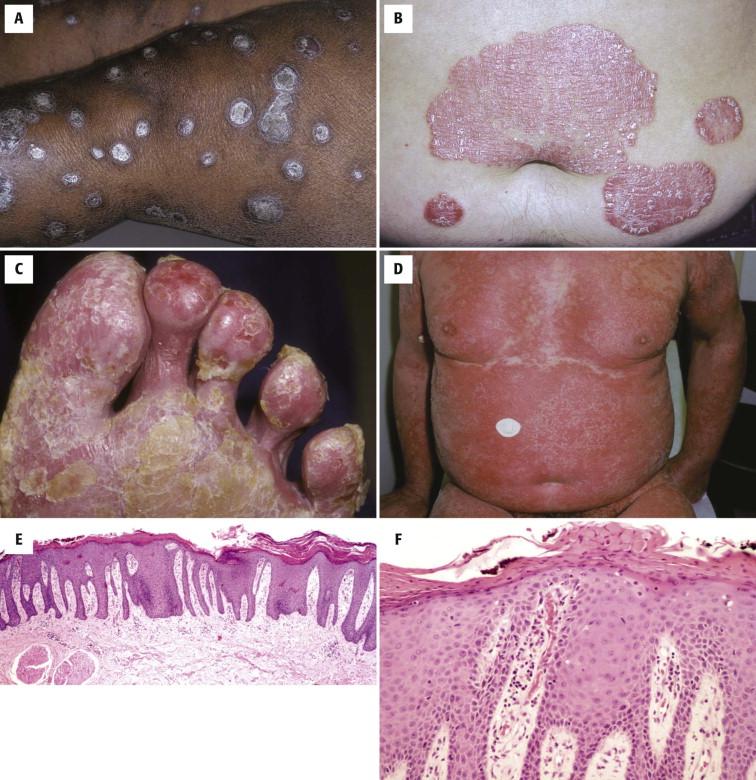
Psoriatic plaques exhibit parakeratosis with horizontally flattened layers of neutrophils, psoriasiform hyperplasia with strikingly regular elongation of slender rete ridges, hypogranulosis, thinned suprapapillary plates, prominent blood vessels within edematous papillary dermal tips, and superficial perivascular predominantly lymphocytic dermal infiltrates ( Fig. 1-9, E–H ). Acute, guttate, or pustular lesions exhibit neutrophilic spongiosis, spongiform pustules (of Kogoj), and Munro microabscesses ( Fig. 1-9, I–L ). Spongiform pustules are intraepidermal collections of neutrophils situated in the stratum malpighii. Munro microabscesses describe neutrophil aggregates in the stratum corneum. Despite the prominence of neutrophils within the epidermis, they are not prominent within the dermis. Eosinophils are usually not prominent in psoriasis.
Chronic plaque lesions
Psoriasiform epidermal hyperplasia
Multilayered mounds of parakeratosis and orthohyperkeratosis
Neutrophils cluster in a parakeratotic stratum corneum (microabscess of Munro)
Neutrophil cluster in stratum malpighii (spongiform pustule of Kogoj)
Diminished or absent granular cell layer (hypogranulosis)
Thinning of suprapapillary plate
Hypervascular edematous dermal papillae
Guttate psoriasis
Less hyperplasia, more inflammation and spongiosis
Pustular psoriasis
Dense accumulation of neutrophils
Consider PAS stain to exclude fungal infection
Chronic spongiotic dermatitis
Lichen simplex chronicus
Drug reaction
Mycosis fungoides
Dermatophytosis
Pustular psoriasis: immunobullous disorders, pustular drug reaction, infection
PAS, periodic acid-Schiff.
A PAS or GMS stain may help exclude a fungal infection associated with a psoriasiform histologic reaction pattern.
Psoriasis is usually diagnosed based on clinical features alone, without biopsy or ancillary studies. Biopsy is more likely to be performed when the clinical features or response to therapy is unusual. For classic plaques, dermatophytosis, chronic spongiotic dermatitis, psoriasiform drug reactions, necrolytic migratory erythema (NME), and patch or plaque stage MF may enter the differential diagnosis. Reiter syndrome is histopathologically indistinguishable from pustular psoriasis. In chronic spongiotic dermatitis, the elongated rete ridges are usually less uniform in length, and the granular layer tends to be preserved or even thickened, and spongiosis is more prominent. Vesiculopustular dermatophytosis needs to be excluded. Psoriasis may represent a common underlying etiology of exfoliative erythroderma. However, erythroderma is a final common pathway of several disorders, including MF, Sézary syndrome, atopic dermatitis, PRP, drug reactions, and others. Diagnosis of erythroderma depends on identification of specific histopathologic attributes of the underlying disorder. In many examples of erythroderma, specific histopathologic features may be subtle. Spongiotic dermatitis is more likely to become impetiginized than psoriasis, so clusters of coccobacteria may be present within the neutrophilic crusts of spongiotic dermatitis. NME may present as psoriasiform dermatitis and neutrophilic spongiosis, without the prominent necrolysis that would most easily identify it. NME usually exhibits pronounced pallor in the upper epidermis. Patch stage MF often displays psoriasiform hyperplasia with a denser lichenoid infiltrate and disproportionate exocytosis of lymphocytes (epidermotropism).
Psoriasis exhibits a variable, unpredictable course that is frequently chronic or waxing and waning. Guttate eruptions in children and young adults may have the highest chance of complete remission. Therapy is individualized, largely based on disease severity, and includes topical and intralesional steroids; topical retinoids; topical calcipotriene; topical coal tar or anthralin; broad- or narrow-band ultraviolet B phototherapy; photochemotherapy (psoralen plus ultraviolet A [PUVA]); or systemic agents such as methotrexate, cyclosporine, and acitretin. Biologic agents include etanercept, infliximab, adalimumab, and ustekinumab.
Lichen simplex chronicus is a localized thickening, hyperpigmentation, and lichenification secondary to chronic rubbing ( Fig. 1-10, A ). The cause of the rubbing is usually pruritus, which produces a habitual, intractable, itch–scratch cycle. Lesions may appear to arise de novo, but more often lichenification occurs in the setting of chronic spongiotic dermatitis, particularly atopic dermatitis. Prurigo nodularis (picker's nodule, chronic prurigo) can be regarded as the papulonodular counterpart of LSC. Prurigo nodularis may arise at focal sites of inflammation, such as insect bites or folliculitis, or in patients with generalized pruritus associated with systemic disease such as chronic renal failure. Prurigo nodules are firm, smooth or slightly rough dome-shaped papules or nodules that are often hyperpigmented or crusted. Patients generally admit to manipulating the lesions.
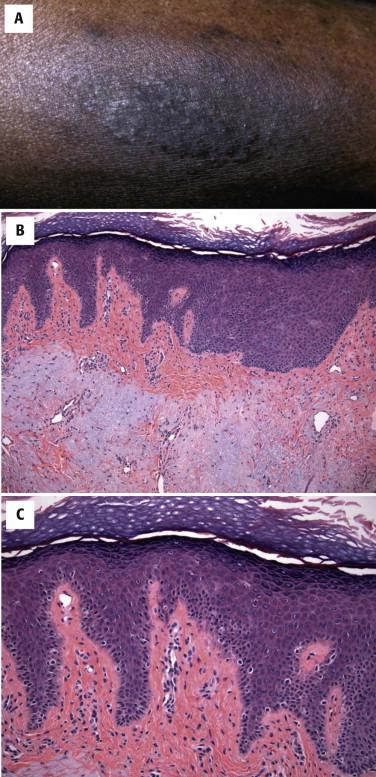
Lichen simplex chronicus and prurigo nodularis are characterized by compact orthokeratosis, epidermal and follicular epithelial hyperplasia with hypergranulosis resembling acral skin (hairy palm sign), and papillary dermal fibrosis with vertically oriented blood vessels within fibrotic dermal papillae ( Fig. 1-10, B, C ). Residual mild spongiosis is often present. In prurigo nodularis a dome-shaped configuration is evident, and follicular epithelial hyperplasia and hypergranulosis are prominent.
Any chronic spongiotic dermatitis may eventuate in LSC. Dermatophytosis should still be excluded. Psoriasis may resemble LSC, but LSC typically exhibits a thickened stratum corneum containing predominantly orthokeratosis rather than parakeratosis, hypergranulosis, and more irregular elongation of rete ridges. If hypogranulosis is present, it is confined to areas of visible spongiosis or excoriation. In LSC, there is no tendency to thinned suprapapillary plates, and a variable degree papillary dermal fibrosis, often with a scarlike configuration of collagen fibers oriented parallel to the epidermal surface, is characteristic. To the extent that papillomatosis is present, an antecedent or regressing verruca vulgaris may be suspected.
Lichen simplex chronicus is often refractory to treatment. The itch–scratch cycle may be broken by treatment with potent topical corticosteroids or sedating oral antihistamines such as hydroxyzine, diphenhydramine, or doxepin. Occlusive therapy, with or without corticosteroids, may be helpful. Refractory prurigo nodularis has been reported to improve with phototherapy or thalidomide.
Pityriasis rubra pilaris is a chronic, idiopathic disorder characterized by red-orange follicular papules that coalesce into well-demarcated confluent plaques leaving characteristic islands of sparing ( Fig. 1-11, A ). Lesions typically progress from rostral to caudal, with many patients presenting with initial involvement of the face and scalp (hair and teeth are normal), followed by palmoplantar keratoderma and generalized involvement. Erythroderma may ensue. Many patients are photosensitive. Erythroderma may result in severe cases. Localized, familial, and juvenile variants have been described. Acquired cases often exhibit abrupt onset, but familial cases may have a more gradual onset. Nail changes include splinter hemorrhages, yellow-brown discoloration, and nail plate thickening.
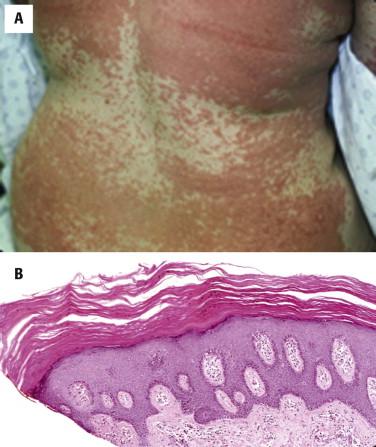
Pityriasis rubra pilaris is characterized by alternating orthokeratosis and parakeratosis, both vertically and horizontally, producing a checkerboard pattern in the stratum corneum in histologic sections ( Fig. 1-11, B ). There are usually psoriasiform hyperplasia, preservation of the granular layer, follicular plugging, and sparse superficial perivascular lymphocytes. Spongiosis, if present at all, is minimal. Focal acantholytic dyskeratosis may be present.
Compared with psoriasis, the epidermal hyperplasia in PRP is usually more irregular (rete ridges more variable in length), the granular layer is preserved, and neutrophils in the stratum corneum are not typical of PRP. Follicular plugging is not characteristic of psoriasis. Focal acantholytic dyskeratosis may represent a somewhat characteristic finding in this histologic context but is not present in most examples of PRP.
The superficial dermal perivascular lymphocytes in PRP are typically sparse compared with psoriasis and chronic spongiotic dermatitis. If regressing chronic spongiotic dermatitis is sampled, the findings may be indistinguishable from PRP unless additional features, such as follicular plugging or a classic checkerboard pattern in the stratum corneum, are identified. When the histopathologic features are not diagnostic, clinical correlation is essential to establish the diagnosis.
Classic, acquired, generalized PRP runs a chronic, waxing and waning course. Familial PRP persists throughout life. Therapy includes topical keratolytics; systemic photochemotherapy; retinoids (including isotretinoin and acitretin); and for refractory cases, cyclosporine, low-dose methotrexate, or other systemic agents.
Necrolytic migratory erythema is a paraneoplastic reaction usually associated with an islet cell glucagon-secreting malignancy (glucagonoma) of the pancreas. Patients present with diabetes mellitus, weight loss, anemia, glossitis, and erythematous erosive desquamating plaques that tend to develop in flexural skin folds such as the groin and axilla ( Fig. 1-12, A ).
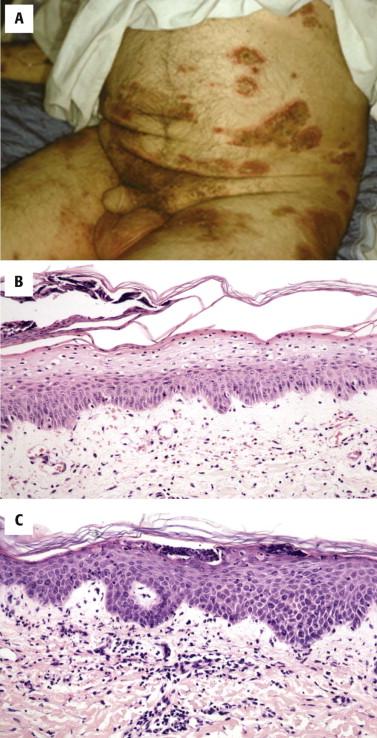
The histologic features are variable, but the most distinctive finding is pronounced pallor of the upper epidermis associated with necrolysis, which is characterized by vacuoles within the cytoplasm of superficial epidermal keratinocytes, resulting in confluent necrosis in the upper epidermis ( Fig. 1-12, B ). Confluent parakeratosis is usually present. Plaques in NME often exhibit psoriasiform hyperplasia. Other findings occasionally present include neutrophilic crust, neutrophilic spongiosis, subcorneal pustule formation ( Fig. 1-12, C ), sparse eosinophils, or single necrotic or dyskeratotic keratinocytes.
Serum glucagon levels are typically elevated. Imaging studies usually reveal a pancreatic mass lesion.
Psoriasis, particularly early lesions, and PRP may exhibit pallor in the upper epidermis but not to the degree that is achieved in the fullest expression of NME, wherein the accompanying necrolytic changes are quite distinctive. Necrolysis is not a feature of psoriasis or PRP. Other forms of deficiency dermatitis, such as zinc deficiency (acrodermatitis enteropathica), riboflavin, and niacin (vitamin B 3 ) deficiency (pellagra), may also exhibit necrolysis and keratinocyte pallor and are best distinguished based on clinical and laboratory features.
Patients with NME often respond dramatically (within hours to days) to surgical removal of the glucagonoma. Patients are typically amino acid deficient, and intravenous amino acid infusion has also been associated with rapid resolution of the skin lesions.
Similar to spongiotic dermatitis and psoriasiform dermatitis, interface dermatitis is a descriptive phrase used by pathologists in dermatopathology reports that is not a specific disease entity ( Table 1-3 ). Interface dermatitis describes a pattern of inflammation in which lymphocytes aggregate around the interface of the dermal-epidermal junction, obscuring the junction at scanning magnification. T lymphocytes mediate damage to the basement membrane zone and the keratinocytes above them, the microscopic hallmarks being junctional vacuolar alteration and single keratinocyte necrosis. Vacuolar alteration is characterized by small, empty, circular spaces of varying diameter along the dermal-epidermal junction. Single necrotic keratinocytes exhibit homogeneous (nongranular) eosinophilic cytoplasm and a shrunken, pyknotic, intensely basophilic nucleus. Depending on the plane of section, the nucleus may not be visible. In some examples of interface dermatitis, such as lichen planus (LP), the necrotic keratinocytes have been shown to be undergoing apoptosis. In other examples, such as acantholytic dyskeratosis (see Grover's disease or Darier's disease), similar-appearing cells are attributable to abnormal differentiation (“dyskeratosis”). Thus, from the standpoint of routine practice, necrotic, dyskeratotic, and apoptotic keratinocytes (also known as “dead reds”) are interchangeable when evaluating routine stained sections of a specimen without prior knowledge of the diagnosis. Secondary spongiosis is invariably present in interface dermatitis, but the presence of interface dermatitis generally takes precedence over spongiosis for the purposes of differential diagnosis. Cases that show overlapping patterns suggest a drug reaction. In addition to mild “secondary” spongiosis, limited exocytosis of lymphocytes into the epidermis is expected. Exocytosis is characteristically more prominent in pityriasis lichenoides (see Table 1-3 ) or viral exanthems.
| Erythema Multiforme | Stevens-Johnson/Toxic Epidermal Necrolysis | Lichen Planus | Pityriasis Lichenoides | Lupus Erythematosus | Lichen Striatus | Graft versus Host Disease | Fixed Drug Reaction | |
|---|---|---|---|---|---|---|---|---|
| Vacuolar interface | ++ | ++ | 0 | ± | ± | ± | ± | ± |
| Lichenoid interface | ± | 0 | ++ | ± | ± | ± | ± | ± |
| Basilar squamatization | 0 | 0 | ++ | 0 | ± | 0 | ± | ± |
| Deep perivascular inflammation | 0 | 0 | 0 | ± | ++ | ± | 0 | ++ |
| Follicular involvement | 0 | 0 | ± | 0 | ++ | ± | ++ | 0 |
| Eccrine involvement | 0 | 0 | 0 | 0 | ++ | ++ | ± | 0 |
| Dermal eosinophils | 0 | ± | ± | 0 | 0 | ± | 0 | ++ |
| Dermal neutrophils | 0 | ± | 0 | 0 | 0 | 0 | 0 | ± |
| Lymphocyte exocytosis | ± | ± | ± | ++ | ± | ± | ± | ± |
| Erythrocyte extravasation | ± | ± | 0 | ++ | 0 | 0 | 0 | 0 |
| Epidermal necrosis | ± | ++ | 0 | ± | 0 | 0 | ± | ± |
Interface dermatitis is typically subdivided based on the pattern of inflammation (Ackerman) but alternatively may be subdivided based on associated epidermal changes (LeBoit). Classification based on associated epidermal changes is beyond the scope of this text but recommended for anyone striving to master this subject. Based on the pattern of inflammation, vacuolar interface dermatitis is characterized by sparse lymphocytes along the dermal-epidermal junction with junctional vacuolar alteration and single and/or clustered necrotic keratinocytes. Erythema multiforme (EM) is considered a prototype for this pattern. Lichenoid interface reactions have a bandlike predominantly lymphocytic infiltrate along the dermal-epidermal junction, sometimes filling the entire papillary dermis. LP is the prototype for this category. Thus, the term lichenoid has both a clinical meaning (lesions resembling lichen, typified by LP) and a histologic one (lesions with a bandlike lymphocytic infiltrate below the dermal-epidermal junction). Less commonly, lymphocytes forming a bandlike pattern in the papillary dermis with minimal or absent vacuolar alteration or necrotic keratinocytes may still be classified as lichenoid dermatitis, e.g., the lichenoid variant of pigmented purpura (lichenoid purpura of Gougerot and Blum).
Erythema multiforme encompasses a wide clinical spectrum of severity. The three disorders included under this heading are clinically distinct, and classic EM (EM minor) is also considered pathogenetically distinct from Stevens-Johnson syndrome (SJS; EM major) and toxic epidermal necrolysis (TEN), but all three are united here because they cannot be reliably distinguished based on histology alone. Classic EM is an acute, self-limited, benign disorder characterized by targetoid papules, papulovesicles, or plaques on the extremities and trunk, often with involvement of the palms. Classic targetoid lesions have a dusky or violaceous center surrounded by two concentric rings or zones of pallor and erythema ( Fig. 1-13, A ). As the name suggests, multiple morphologies are possible, including bullous lesions ( Fig. 1-13, B ). EM minor is highly associated with the HSV carrier state, and outbreaks may be accompanied by cold sores or reactivation of latent HSV by ultraviolet light exposure. SJS is a severe acute generalized reaction characterized by involvement of multiple mucosal sites (oral, ocular, genital) in which the disease manifests with prominent hemorrhagic crusting ( Fig. 1-13, C ). Associated discrete or coalescent variably purpuric atypical targetoid lesions (two zones, rather than three) may coexist on the trunk and extremities. SJS is usually associated with recent drug exposure but may also be triggered by infection, including Mycoplasma pneumoniae . TEN is the most severe reaction, defined as widespread sloughing of the epidermal surface on greater than 10% of the total body surface area. TEN is characterized by disproportionate sloughing with minimal erythema compared with EM minor or SJS.
Erythema multiforme (minor) shows similar histologic features with but is clinically distinct from Stevens-Johnson syndrome.
Most often young adults but may occur at any age
Eruption triggered by infection (especially herpes simplex virus) or medication
Extremities (usually upper, especially dorsum of hands and forearms)
Face
Abrupt onset of classic target lesions (acrofacial sites)
Erythematous urticarial papules and plaques
Coalescence of lesions produces a polycyclic appearance
Acute self-limited disease
Acyclovir or valacyclovir if associated with herpes simplex
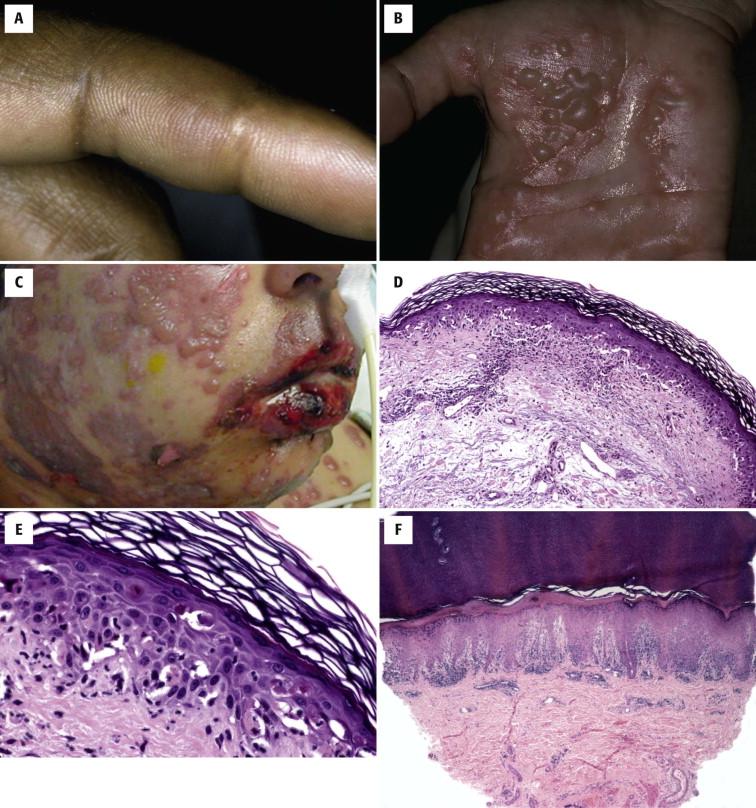
Because the onset of EM is acute, there is usually basket-weave orthokeratosis and vacuolar interface dermatitis with prominent necrosis of single and clustered necrotic keratinocytes both along and above the basal layer ( Fig. 1-13, D, E ). Prominent reactions may display a denser lichenoid infiltrate from scanning magnification ( Fig. 1-13, F–H ), but vacuolar alteration and keratinocyte necrosis remain prominent. When lymphocytes are juxtaposed against necrotic keratinocytes, the term satellite cell necrosis has been used ( Fig. 1-13, H ). (Satellite cell necrosis is not specific for EM.) There are usually sparse superficial perivascular lymphocytes in the dermis. Dermal eosinophils are typically rare or absent. In bullous variants, confluent keratinocyte necrosis and vacuolar alteration result in full-thickness epidermal necrosis and subepidermal blistering ( Fig. 1-13, I, J ). Marked papillary dermal edema is less commonly a second means by which subepidermal blistering may occur. In TEN, perilesional skin may reveal changes indistinguishable from EM or SJS. However, in TEN, there is progression to full-thickness epidermal necrosis and widespread subepidermal blistering and sloughing with sparse inflammation.
Acute vacuolar interface dermatitis
Epidermal necrosis, variable
May be associated with a secondary subepidermal blister
Stevens-Johnson syndrome/toxic epidermal necrolysis (distinction requires clinical context: prodrome of upper respiratory tract syndrome, mucous membrane involvement, extensive exfoliation, association with medication use)
Erythema multiforme–like graft versus host disease
Rowell's syndrome (erythema multiforme–like lesions in patients with lupus erythematosus)
Frozen section analysis of a freshly formed blister roof can facilitate rapid distinction between TEN and staphylococcal scalded skin syndrome.
Although their clinical contexts tend to be mutually exclusive, acute graft versus host disease (GVHD) may be histologically indistinguishable from EM/SJS/TEN. GVHD is more apt to exhibit extension of the vacuolar interface reaction within adnexal epithelium. A frequent clinical differential diagnosis is TEN versus staphylococcal scalded skin syndrome. The latter exhibits a superficial intraepidermal cleavage plane, as per pemphigus foliaceus (see Ancillary Studies). Fixed drug reactions may exhibit similar epidermal changes to EM but usually exhibit neutrophils or eosinophils and sometimes exhibit greater spongiosis, and the inflammation typically involves the deep vascular plexus in the reticular dermis. After repeated episodes, fixed drug reactions also typically have melanophages in the papillary dermis. Pityriasis lichenoides usually exhibits neutrophilic crust, greater lymphocyte exocytosis, and erythrocyte extravasation in the papillary dermis with deep perivascular extension of lymphocytes. However, early lesions of pityriasis lichenoides et varioliformis acuta (PLEVA) may resemble EM. Acute cutaneous lupus erythematosus (LE) may also resemble EM. Acute lupus usually exhibits compact orthokeratosis, epidermal atrophy, relatively sparse single necrotic keratinocytes, and increased interstitial mucin in the underlying dermis. Chemotherapy-induced interface dermatitis is characterized by cytologically atypical keratinocytes and basilar squamatization. Finally, consistent with its etiologic role in most cases of EM, HSV, and varicella zoster virus infections usually exhibit vacuolar interface dermatitis extending along the dermal-epidermal junction peripheral to the diagnostic viral cytopathologic features within the epidermis or follicular epithelium.
Erythema multiforme minor is self-limited, but episodes may recur chronically. Sun protection and avoidance may minimize HSV outbreaks. Episodic or suppressive systemic antiviral therapy with acyclovir, famciclovir, or valacyclovir is usually helpful. SJS and TEN are debilitating and potentially life-threatening conditions that warrant hospitalization. Because of the significant morbidity and mortality and special management challenges associated with TEN, these patients are optimally managed in a surgical intensive care burn unit to use frequent dressing changes, management of fluid and electrolyte status, and monitoring and prevention of sepsis (the most frequent cause of death). The mortality rate may approach 10% to 25%. The role of systemic corticosteroids in the acute management of SJS and TEN is controversial and unproved, although they are frequently administered. Plasmapheresis, intravenous immune globulin, and tumor necrosis factor inhibitors represent additional therapeutic options.
Fixed drug reactions are round, erythematous or violaceous macules or patches that occur on one or a few fixed sites repetitively after repeat exposure to the offending agent. Tetracycline, penicillin, acetaminophen, aspirin, nonsteroidal antiinflammatory agents, dapsone, benzodiazepines, and barbiturates are commonly implicated culprits. The face, extremities, and genitalia are common sites, but any site may be involved. The lesions may vesiculate ( Fig. 1-14, A ). Postinflammatory hyperpigmentation persists for several weeks to months after a single exposure to the offending agent. With repeat exposure, persistent pigmentation intensifies, and additional sites may manifest. The pigmentation is said to have a mercurochrome hue owing to the combination of erythema superimposed on post inflammatory hyperpigmentation.
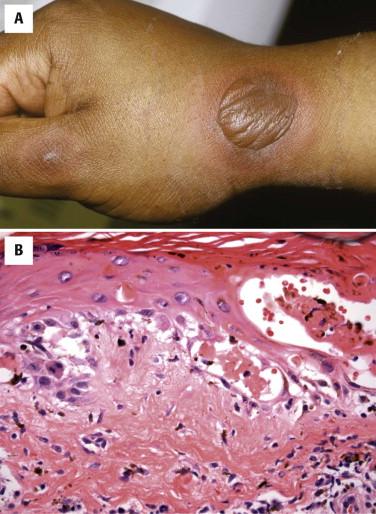
Fixed drug reactions display vacuolar alteration, single or clustered necrotic keratinocytes within the basal and often upper levels of the epidermis ( Fig. 1-14, B ). Spongiosis is variable. Confluent epidermal necrosis is associated with subepidermal cleavage in bullous fixed drug reactions. The dermis contains superficial or superficial and deep perivascular lymphocytes, usually with eosinophils, neutrophils, or both. After repeated flares, melanophages are prominent in the papillary dermis.
The epidermal changes in EM may be indistinguishable from those of fixed drug reactions. Clues that may favor fixed drug reaction include melanophages, slight psoriasiform epidermal hyperplasia, a retained polygonal configuration of the necrotic keratinocytes in the stratum spinosum, and greater spongiosis. Fixed drug reactions are much more likely to involve the deep perivascular plexus and contain eosinophils, neutrophils, or both. In the context of vacuolar interface dermatitis, prominent melanophages are generally a clue to the diagnosis of a fixed drug reaction.
Fixed drug reactions usually resolve within several days. However, with repeat exposure to the offending agent, progressive hyperpigmentation persists. Generalized lesions may develop rarely. Avoidance of the offending drug is curative.
Lichen planus is a relatively common disorder characterized by flat-topped erythematous or violaceous, pruritic papules most commonly involving the wrists or ankles in a symmetric fashion. The papules classically have an angulated or polygonal shape ( Fig. 1-15, A ). Reticulated white lines may be appreciated on the surface of the papules, known as Wickham striae. Oral and genital skin is also commonly involved. In oral LP, the Wickham striae may be the most prominent finding ( Fig. 1-15, B ). Involvement of the nail unit may result in pterygium formation. Hypertrophic LP is common on the shins. In dark-complected individuals, the erythema may be subtle, with hyperpigmentation as the predominant feature. In lichen planopilaris (follicular LP), the disorder is centered on the lower infundibulum and isthmus of hair follicles, where scarring alopecia may result. Annular, atrophic, vesiculobullous, actinic, erosive, and hyperpigmented LP are other clinical variants. Two rare overlap syndromes are the LP–LE overlap and LP pemphigoides.
Usually middle-aged adults (onset usually between ages 30 and 60 years)
Oral mucosa (up to 75% of patients)
Skin of wrist, forearm, genitalia, distal lower extremity
Classic skin lesions: flat-topped violaceous papules and plaques
Variants: linear, bullous, hypertrophic, atrophic, annular skin lesions
Wickham striae (network of fine white lines on surface of lesions)
Mucosa: reticular pattern (most common) of whitish linear streaks; atrophic, erosive, papular or plaque lesions
Nail: lateral thinning, longitudinal ridging, fissuring pterygium
Clinical course variable (self-limited to chronic persistent)
Ulcerative oral, hypertrophic, and nail lichen planus tend to persist
Corticosteroids
Retinoids
Phototherapy
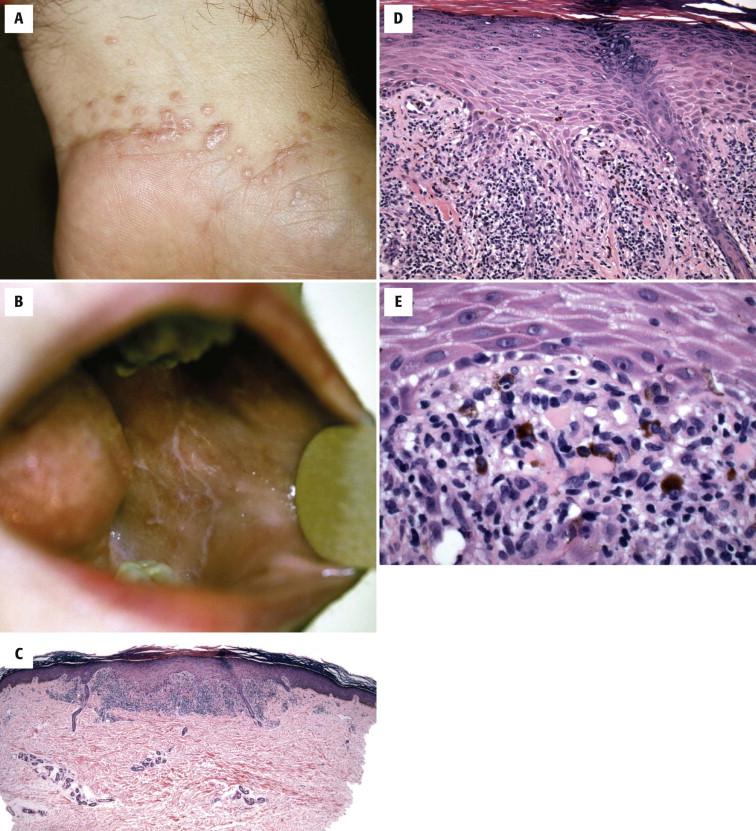
Fully developed LP is primarily an interface dermatitis typified by a dense lichenoid (bandlike) infiltrate obscuring the dermal-epidermal junction ( Fig. 1-15, C-E ). The epidermal changes are most characteristic. Classic LP exhibits compact orthokeratosis, wedge-shaped hypergranulosis overlying jagged sawtooth-shaped rete ridges, and squamatization of the basal layer (basilar squamatization). Squamatization of the basal layer refers to the flattening of basilar keratinocytes resembling the physiologic flattening of keratinocytes in the upper epidermis as they enter the stratum granulosum just prior to terminal differentiation into the stratum corneum. Basilar squamatization is often best appreciated in areas where the rete ridges exhibit a jagged or sawtooth shape and overlying hypergranulosis provides optimal contrast. The areas of hypergranulosis represent an exaggeration of the physiologic hypergranulosis associated with adnexal (follicular, sweat duct) epithelium. In hypertrophic LP, there is pronounced epidermal hyperplasia with acanthosis, papillomatosis, and elongated rete ridges. In atrophic LP, there may be attenuation of the rete ridges and a thinned, atrophic epidermis resembling lupus. In hypertrophic LP, which is typically very pruritic, there is epidermal hyperplasia with papillomatosis and often papillary dermal fibrosis secondary to chronic rubbing. In mucosal LP, the epidermal changes may be less specific, with rounded rather than pointed rete ridges and parakeratosis. In all variants, the lichenoid infiltrate is composed predominantly of lymphocytes. Melanophages are usually present. Pertinent negative findings include absence of prominent dermal eosinophils and absence of deep perivascular extension of the dermal infiltrate. Hypertrophic LP may exhibit greater numbers of eosinophils. Mucosal LP usually contains some plasma cells that may be attributable to the mucosal site. The apoptotic keratinocytes exhibit homogeneous eosinophilic cytoplasm and sometimes a pyknotic basophilic nucleus (the nucleus may not be observed depending on the plane of section). They are mostly present along the dermal-epidermal junction but may also be found in the upper levels of the epidermis or in the papillary dermal lichenoid infiltrate. In the context of LP, the anucleate remnants of these apoptotic keratinocytes have been named Civatte bodies (colloid bodies, cytoid bodies) when present in the papillary dermis. Focal subepidermal clefts formed by confluent vacuoles have been termed Max-Joseph spaces.
Epidermal hyperplasia with compact orthokeratosis, hypergranulosis, and bandlike lymphocytic infiltrate
Sawtoothing of rete ridges
Civatte bodies
If crust or eosinophils are present, consider PAS stain to exclude dermatophyte
Direct immunofluorescence: basement membrane zone fibrinogen
Lichen planus–like keratosis
Lichenoid drug reaction (distinction best done clinically: nonclassic sites involved, mucous membranes often spared; history of medication use)
Although biopsy is typically performed to confirm the diagnosis of LP, DIF studies are not routinely required to establish the diagnosis. However, immunofluorescence studies routinely show globular deposition of IgM at the dermal-epidermal junction, corresponding to the apoptotic cells. LP may be associated with hepatitis C virus (HCV) infection in fewer than 30% of cases.
Lichen planus may be histologically indistinguishable from a LP-like keratosis (lichenoid keratosis, benign lichenoid keratosis), but the clinical setting is usually sufficient to distinguish these two disorders. Whereas LP is characterized by multiple lesions and usually sampled by punch (trephine) biopsy, LP-like keratoses are solitary lesions, most commonly on the trunk of an adult, and sampled by shave biopsy to rule out carcinoma. Compared with LP, LP-like keratosis usually exhibits some parakeratosis and does not invariably contain the distinctive epidermal changes (basilar squamatization, jagged rete, wedge-shaped hypergranulosis) requisite for LP. Lichenoid drug reactions (e.g., thiazide diuretics, beta-blockers, antimalarials, furosemide, spironolactone) also exhibit parakeratosis, as well as dermal eosinophils and deep dermal perivascular extension of lymphocytes and eosinophils. Lichenoid drug reactions also do not invariably contain the epidermal changes of LP, and single necrotic keratinocytes may be present in the upper epidermis, including the stratum corneum. Lichenoid variants of the pigmented purpuric dermatoses, including lichenoid purpura (Gougerot-Blum) and lichen aureus, contain extravasated erythrocytes or hemosiderin-containing histiocytes (siderophages), whose pigment can be highlighted by hemosiderin stain. The lichenoid variant of chronic GVHD may resemble LP clinically and histopathologically; clinical correlation is required. In lichenoid GVHD, the lichenoid infiltrate is typically sparse, and dermal eosinophils or plasma cells may be present. Discoid LE may exhibit basilar squamatization but, additionally, epithelial atrophy, basement membrane thickening, deeper and denser perivascular and perifollicular lymphocytes (usually devoid of eosinophils), and increased interstitial mucin deposition. Some instances in which features of both LP and lupus were present have been termed lupus erythematosus–LP overlap . Lichen striatus may resemble LP but typically exhibits lymphocytes and sometimes admixed histiocytes associated with eccrine sweat glands in the reticular dermis. Lichen nitidus exhibits a ball-in-claw configuration of rete ridges surrounding the lichenoid lymphohistiocytic infiltrate that may exhibit overt granulomatous features with multinucleated histiocytes. Lichenoid mucositis secondary to candida exhibits spongiosis, neutrophilic pustules, eosinophils, and pseudohyphae within the superficial epithelium.
Lichen planus typically runs a chronic but self-limited course, often resolving after 3 to 5 years. Therapeutic options include potent topical corticosteroids; short courses of systemic corticosteroids; photochemotherapy; systemic retinoids; and for refractory cases, other systemic immune suppressive agents. Chronic erosive lesions should to be examined regularly to rule out secondary squamous cell carcinoma.
Pityriasis lichenoides is an idiopathic disorder that can be viewed as a clinical and histopathologic spectrum with the clinical disorders PLEVA (Mucha Habermann disease) at one end, and pityriasis lichenoides chronica (PLC) at the other. PLEVA usually affects children and young adults, with widespread vesicles and hemorrhagic, erythematous, minimally symptomatic papules that ulcerate and leave focal varioliform (smallpox-like) scars ( Fig. 1-16, A, B ). A severe hyperacute ulceronecrotic variant of PLEVA is characterized by fever, constitutional symptoms, and larger ulcerations and has been associated with Epstein-Barr virus or cytomegalovirus infections. PLC runs a mild chronic course with randomly scattered minimally symptomatic erythematous papules in children or adults. PLC typically does not ulcerate or scar. Cases with intermediate or overlapping features of PLEVA and PLC may occur.
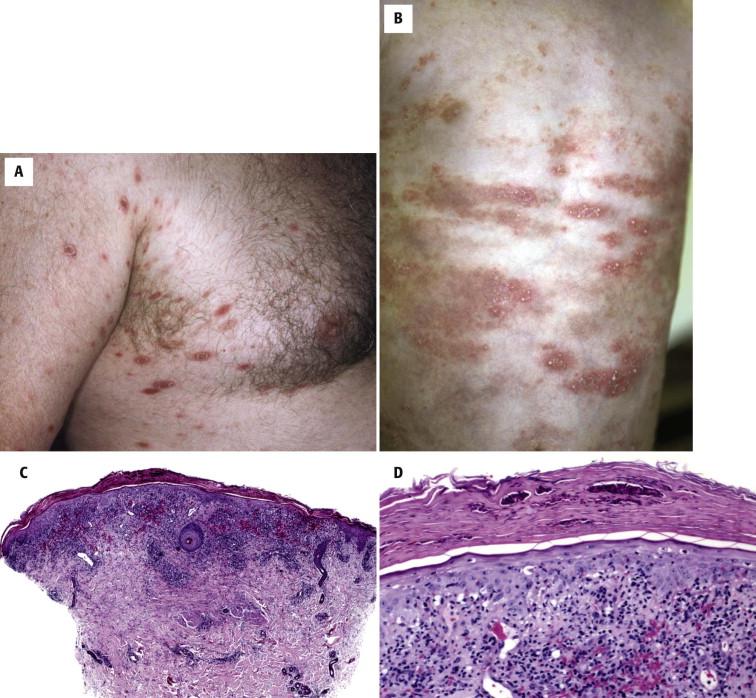
Pityriasis lichenoides et varioliformis acuta is characterized by parakeratotic neutrophilic crust, vacuolar interface dermatitis with lymphocyte exocytosis, papillary dermal hemorrhage, and superficial and deep wedge-shaped lymphocytic infiltrates ( Fig. 1-16, C, D ). Despite the characteristic neutrophilic crust in PLEVA, neutrophilic spongiosis or dermal neutrophilia are not prominent. Dermal eosinophils are rare and often entirely absent. Fully developed lesions have a lichenoid infiltrate below the dermal-epidermal junction. Dense infiltrates of lymphocytes in and around blood vessels is often noted, so-called lymphocytic vasculitis . Additional evidence of vasculitis, namely fibrin within vessel walls, is only occasionally present. In PLC, the perivascular lymphocytes are often sparser and confined to the upper dermis. Parakeratosis, interface dermatitis, and lymphocyte exocytosis are usually present, but a neutrophilic crust and erythrocyte extravasation may be minimal or absent.
Pityriasis rosea may resemble pityriasis lichenoides. Both conditions may exhibit overlapping spongiotic and interface features with lymphocyte exocytosis and erythrocyte extravasation. However, epidermal changes in PR are predominantly spongiotic, but in pityriasis lichenoides, they are predominantly interface. The presence of neutrophilic crust; dense, deep dermal perivascular involvement; or lymphocytic vasculitis favors PLEVA over PR. Neutrophilic crust is also typical of psoriasis, spongiotic dermatitis, and dermatophytosis, but interface dermatitis is not typical of any of these, and histochemical staining for fungi will identify rare cases of dermatophytosis manifesting an interface reaction.
Pityriasis lichenoides should not contain atypical lymphocytes. In the past, the designation lymphomatoid pityriasis lichenoides was proposed. However, if atypical lymphocytes with convoluted or cerebriform nuclear contours are present, lymphomatoid papulosis or MF should be suspected. If scattered large atypical CD30-positive lymphocytes with prominent nucleoli are present in the dermis, the diagnosis is probably lymphomatoid papulosis (type A pattern). If small to medium convoluted or cerebriform lymphocytes are present within the epidermis, then lymphomatoid papulosis (type B pattern) is a consideration. Lymphocyte exocytosis without overt atypia may be observed in both pityriasis lichenoides and patches of MF. In MF, lymphocytes tend to aggregate in the basilar epidermis, and necrotic keratinocytes, vacuolar alteration, and spongiosis are not prominent. Prominent eosinophils are not typical of pityriasis lichenoides or MF. In pityriasis lichenoides, the lymphocyte are more scattered throughout all levels of the epidermis with greater spongiosis or interface changes, and deep perivascular lymphocytes are typical.
Become a Clinical Tree membership for Full access and enjoy Unlimited articles
If you are a member. Log in here